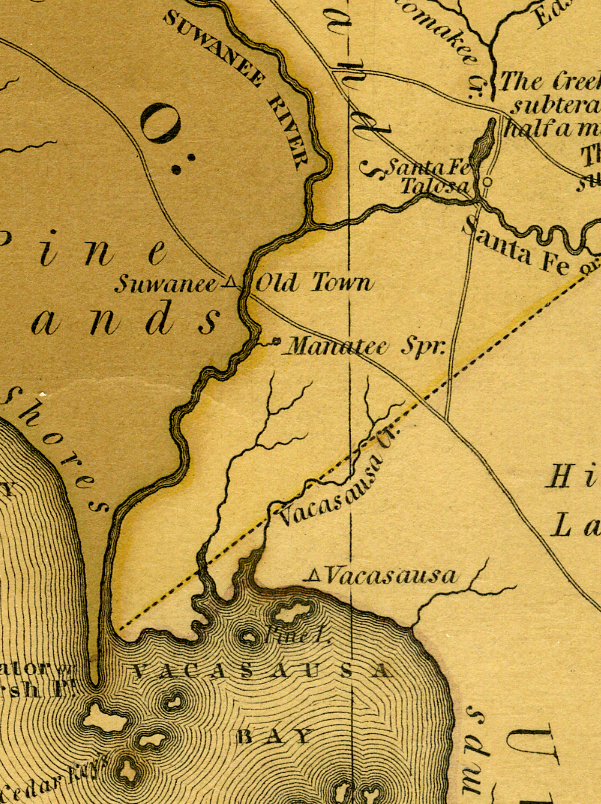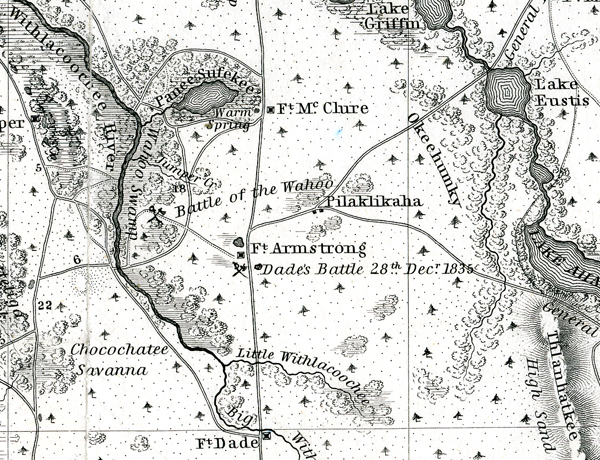Description of previous item
Description of next item
Florida's Underground Railroad: The Black Seminoles
Published February 2, 2013 by Florida Memory
Many might assume that the Underground Railroad traveled in one direction: north to freedom, away from slavery and the plantations of the South. Few realize that runaway slaves also fled south into Florida for almost two centuries before the Civil War.
Runaway slaves forged close alliances with the Florida Seminoles in the 18th and early 19th centuries. Historians struggle to find an appropriate term for persons of African descent living in Seminole Country. In Florida, these people came to be known to historians as "Black Seminoles"or "Seminole Maroons."

Excerpt from an 1823 map of Florida by H.S. Tanner showing Suwannee Old Town, situated on the path from Tallahassee to Alachua
Prior to the Seminole Wars, Black Seminole communities could be found near Old Town on the Suwannee River, north of Tampa at Pilaklikaha, and near modern day Sarasota at a settlement sometimes referred to as Angola. Other smaller Black Seminole settlements existed throughout this range.

Excerpt from “A Map of the Seat of War in Florida” by Captain John Mackay and Lieutenant J. Black, U.S. Topographical Engineers, 1839, showing battles and natural features near Pilaklikaha
On several occasions Seminoles and their African allies banded together in the defense of their homelands.
In 1812, a combined force of Africans and Seminoles repelled Georgians known as the "Patriot Army"who intended to capture slaves and seize parts of Spanish Florida for the United States.
The success against the Patriot Army was followed by a series of defeats. On July 20, 1816, the Americans destroyed the "Negro Fort"on the Apalachicola River. The fort, built by the British in the closing stages of the War of 1812, held hundreds of defenders who were killed when a heated cannon ball blew up the powder magazine.
The American drive to acquire Florida caused further hardship for Black Seminoles. After Andrew Jackson's slave raid into Spanish Florida, also known as the First Seminole War (1816-1818), most Africans abandoned their towns along the Suwannee River and took refuge further south in the remote interior sections of central Florida.
The number of runaway slaves in Florida increased when the United States acquired Florida from Spain in 1821. As planters from Georgia and the Carolinas arrived in northern Florida, some of the people they held in bondage escaped and joined the Seminoles. Article VII of the treaty made at Camp Moultrie in September 1823 compelled the Seminoles to be "active and vigilant"in preventing runaway slaves from entering their territory. Moreover, the treaty required Seminoles to "apprehend and deliver"fugitive slaves to federal agents.
Seminoles and Black Seminoles pushed back when American officials attempted to enforce the Indian Removal Act in Florida. In late 1835 and early 1836, Seminoles and their African allies launched a series of raids on U.S. Army fortifications and attacked sugar plantations in East Florida. Africans enslaved on these plantations fled during the chaos and in many cases joined the Black Seminoles.
These events marked the beginning of the Second Seminole War (1835-1842), the longest and costliest American Indian War in U.S. history. Because of the prominent role of Africans in the conflict, General Thomas Sidney Jesup famously proclaimed, "This is a negro, not an Indian war"Historians consider this statement reflective of southern plantation owners' fears of the Seminole Wars erupting into a broader slave rebellion.
Abraham, a Black Seminole interpreter, figured prominently in the tense negotiations during the early stages of the Second Seminole War.
Abraham delivered messages on several occasions to General Jesup from principal Seminole leaders and also participated in talks with U.S. military officials. In the entry below from his field diary, dated March 18, 1837, Jesup mentions spending the "whole evening"in conference with Seminole leaders accompanied by Abraham.
The end of the Seminole Wars in 1858 struck a major blow to the aspirations of runaway slaves in Florida. No longer able to find freedom in Seminole Country, runaway slaves increasingly sought the Underground Railroad or, during the Civil War, service in the Union Army as the path to escape slavery.
To learn more about the African peoples who resisted slavery in the southeast, visit the National Park Services' Gullah/Geechee Cultural Heritage Corridor website.
Cite This Article
Chicago Manual of Style
(17th Edition)Florida Memory. "Florida's Underground Railroad: The Black Seminoles." Floridiana, 2013. https://www.floridamemory.com/items/show/257951.
MLA
(9th Edition)Florida Memory. "Florida's Underground Railroad: The Black Seminoles." Floridiana, 2013, https://www.floridamemory.com/items/show/257951. Accessed December 5, 2025.
APA
(7th Edition)Florida Memory. (2013, February 2). Florida's Underground Railroad: The Black Seminoles. Floridiana. Retrieved from https://www.floridamemory.com/items/show/257951

 Listen: The Assorted Selections Program
Listen: The Assorted Selections Program